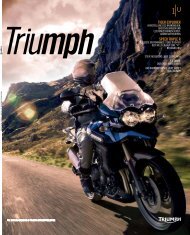Angels - PageSuite
Angels - PageSuite
Angels - PageSuite
Create successful ePaper yourself
Turn your PDF publications into a flip-book with our unique Google optimized e-Paper software.
AMAZONAS<br />
48<br />
COVER<br />
STORY<br />
Angelfish: Genetic Transparency<br />
Changes Everything<br />
article and images by Matt Pedersen, with additional images by Mellow<br />
Aquatics and Raiko Slavkov Aquarists who know me would<br />
argue that I am a marine fish breeder. I made a name for myself<br />
as the first and only person to breed the “impossible to keep<br />
alive” Harlequin Filefish (Oxymonacanthus longirostris).<br />
Only the folks who know me really well understand that I<br />
don’t discriminate on the basis of salt content! My recent<br />
fishroom expansion finally gave me the space to seek<br />
out one of my next challenges in fresh water.<br />
An F2 “50%<br />
Manacapuru” Silver<br />
(wild-type) angelfish. This is<br />
genetically a blank canvas (+/+) in<br />
the designer-breeder’s mind. However,<br />
it is the second generation (F2) grandchild<br />
of a wild outcross. Its grandparents were a<br />
Platinum Veil (g/g - V/+ - pb/pb) and a wild<br />
Manacapuru Angelfish. Given the genetics<br />
of its grandparents and parents, this<br />
outwardly wild-type fish could carry hidden<br />
recessive genes (Gold and Philippine<br />
Blue).<br />
I am in love with the Altum Angelfish (Pterophyllum<br />
altum), and I am no stranger to the difficulty this<br />
species represents (insert expletives here). I always<br />
tell marine breeders, “Start with something easy and<br />
similar to your end goal.” In doing so, you make the<br />
beginner mistakes early on, leaving you prepared to later<br />
handle the complexities of something more sensitive<br />
or challenging. I had never bred the ubiquitous Freshwater<br />
Angelfish (P. scalare), so it made sense to learn with<br />
the classic angelfish before tackling the Altum.<br />
However, while getting my feet wet with angelfishes,<br />
I was quickly sidetracked by the intriguing world of<br />
angelfish genetics. This forever altered my viewpoint on<br />
the breeding of “designer fish” in the face of an ongoing<br />
need to consider the conservation implications of what<br />
we do as fish breeders.<br />
A revelation<br />
The free and open discussion of angelfish genetics<br />
among breeders provided an excellent model to bring<br />
back to the saltwater side of the breeding world, where<br />
the fledgling “designer clownfish” craze had me questioning<br />
whether there was a future for the original<br />
wild form of something like the Common Ocellaris<br />
Clownfish (Amphiprion ocellaris). Five years ago, I<br />
bemoaned the “guppification” of clownfishes, insisting<br />
that designer forms could push wild forms out of the<br />
aquarium world. Through my work with the Lightning<br />
Maroon Clownfish (a mutation discovered twice on the<br />
reefs of Fisherman’s Island, Papua New Guinea) and my<br />
surprise exposure to the fascinating world of angelfish<br />
MATT PEDERSEN




